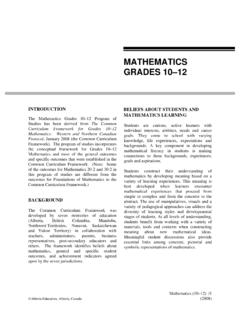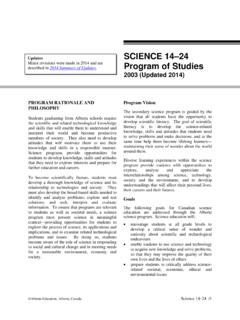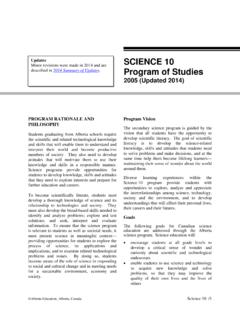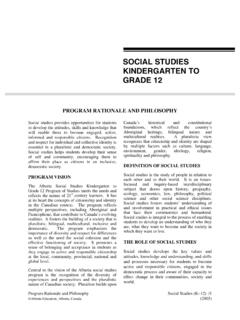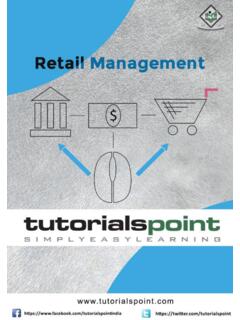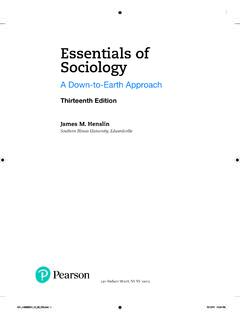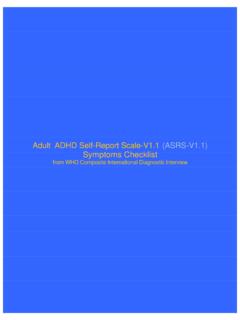Transcription of Instructional Strategies - Alberta
1 Health and Life Skills Guide to Implementation (K 9) Instructional Strategies /67 Alberta Learning, Alberta , Canada 2002 Instructional Strategies What are Instructional Strategies ? Instructional Strategies are techniques teachers use to help students become independent, strategic learners. These Strategies become learning Strategies when students independently select the appropriate ones and use them effectively to accomplish tasks or meet goals. Instructional Strategies can: motivate students and help them focus attention organize information for understanding and remembering monitor and assess learning. To become successful strategic learners students need: step-by-step strategy instruction a variety of Instructional approaches and learning materials appropriate support that includes modelling, guided practice and independent practice opportunities to transfer skills and ideas from one situation to another meaningful connections between skills and ideas, and real-life situations opportunities to be independent and show what they know encouragement to self-monitor and self-correct tools for reflecting on and assessing own learning.
2 Effective Instructional and learning Strategies can be used across grade levels and subject areas, and can accommodate a range of student differences. Instructional Strategies that are especially effective in the health education program include: cooperative learning group discussion independent study portfolio development journals and learning logs role-playing cognitive organizers literature response service learning issue-based inquiry. 68/ Instructional Strategies Health and Life Skills Guide to Implementation (K 9) 2002 Alberta Learning, Alberta , Canada Cooperative learning Cooperative learning involves students working in small groups to complete tasks or projects. Tasks are structured so that each group member contributes to the completion of the task. Success is based on the performance of the group rather than on the performance of individual students.
3 Program benefits Cooperative learning activities play an important role in increasing students respect for and understanding of each other s abilities, interests and needs. These activities encourage students to take responsibility for their learning. Tips for getting started Consider the following suggestions for successful cooperative learning in the health education classroom. Keep groups small two to five members is best (the larger the group, the more skillful group members must be). Create diverse groups; this allows everyone to learn from each other s differences. Structure groups in such a way that success depends on each group member being responsible for some part of the task. Initially, group students and assign roles within each group. Teach basic routines for classroom management, including forming groups quickly and quietly, maintaining appropriate noise levels, inviting others to join the group, treating all students with respect and helping or encouraging peers.
4 Monitor behavioural expectations by scanning groups, using proximity and friendly reminders, sitting and watching a group for a while, revisiting expectations, and when necessary, reteaching expectations. Ensure individual students are aware of their roles and responsibilities within the group. Post a list of roles or give students cards describing specific roles. Discuss and model collaborative skills, such as listening, allowing others to speak, asking for help when needed, reaching consensus and completing a task within the allotted time. Students need opportunities to practise these skills, and receive feedback and reinforcement. Allow students time to evaluate the cooperative learning process, both individually and as a group. Think pair share In think pair share, the teacher poses a topic or question. Students think privately about the question for a given amount of time, usually one to three minutes.
5 Each student then pairs with a partner to discuss the question, allowing students to clarify their thoughts. Next, each pair has an opportunity to share their answers with the whole class. Health and Life Skills Guide to Implementation (K 9) Instructional Strategies /69 Alberta Learning, Alberta , Canada 2002 Think pair share is a cooperative learning strategy that provides opportunities for students to: participate learn from others make connections. Forming learning groups There are many Strategies to choose from when forming cooperative learning groups. Using a variety of Strategies ensures that students have an opportunity to work with many different group members throughout the year.
6 Consider the following Strategies for forming groups. Pairing up partners Students pair up with someone who falls into the same category. For example, students pair up with the first person they meet who is wearing the same colour socks as them. Pick a card Use old decks of cards to form groups. For example, to get groups of four, put together four king of spades, four queen of diamonds, and so on. Distribute the cards randomly and ask students to find the others with matching cards. Chalkboard list This is a good strategy to use when students are finishing their work at different times. As students complete one assignment, they write their names on the chalkboard. When three names accumulate, they form a new group and move on to the next activity. For additional ideas on forming learning groups, see Energize! Energizers and Other Great Cooperative Activities for All Ages by Carol Apacki.
7 Group roles The roles in a cooperative learning group depend on the task. Before assigning roles, review the task and determine what roles are necessary for the group to be successful. Roles could include:3 Checker Ensures that everyone understands the work in progress. Timekeeper Watches the clock and makes sure the group finishes the task within the time allotted. Questioner Seeks information and opinions from other members of the group. Recorder Keeps a written record of the work completed. 1. Lee 1. Eric 1. 1. 2. Sam 2. Haijia 2. 2. 3. Rain 3. 3. 3. 70/ Instructional Strategies Health and Life Skills Guide to Implementation (K 9) 2002 Alberta Learning, Alberta , Canada Reporter Reports on the group s work to the rest of the class. Encourager Encourages everyone in the group to contribute and offers positive feedback on ideas.
8 Materials manager Gathers the material necessary to complete the task. At the end of the task, the materials manager returns materials and turns in the group s work. Observer Completes a checklist of social skills for the group. When introducing roles to the class, explain and model them. Give students opportunities to practise. Emphasize that all roles are equally important and contribute to the success of the group. Students need many opportunities to work in small groups to improve their ability to be part of a team. The number one reason people fail at their jobs is their inability to get along with coworkers. Cooperative learning creates opportunities for students to learn and apply important social and communication skills. Cooperative learning is an effective strategy for the health education classroom. It enhances perspective, encourages higher-level reasoning, creates social support and provides opportunities for students to participate in meaningful, thoughtful activity.
9 Group achievement marks One controversial aspect of cooperative learning is whether or not to assign group achievement marks . spencer Kagan, in O Connor s The Mindful School: How to Grade for Learning, argues against using a group achievement mark for the following reasons. Group marks convey the wrong message. If grades are partially a function of forces entirely out of students control, such as who happens to be their partners, that sends students the wrong message. Group marks violate individual accountability if individual students find ways to manipulate situations to their advantage. Group achievement marks are responsible for parents , teachers and students resistance to cooperative learning. Rather than awarding group achievement marks , Kagan suggests providing feedback in written form on students cooperative learning skills. Kagan believes students will work hard if they know in advance that such feedback will occur.
10 He also suggests asking students to set their own goals and use self-assessment to promote learning and improve social skills. Health and Life Skills Guide to Implementation (K 9) Instructional Strategies /71 Alberta Learning, Alberta , Canada 2002 Group discussions Group discussions are an integral part of the health and life skills classroom. They are essential for building background on specific issues, creating motivation and interest, and giving students a forum for expressing and exploring new ideas and information. Group discussions help students learn to articulate their views and respond to opinions that differ from their own. Group discussions may involve the whole class or a small group.

